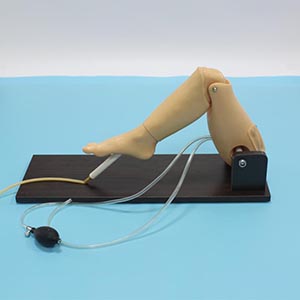31-12-2024
ADA MED SUPPLY LIMITED
Article tag: Bone puncture and femoral vein puncture models BIX-L65A
Bone puncture and femoral vein puncture are common and technically demanding operations in clinical medicine, widely used in bone marrow puncture, vascular catheterization, drug therapy and other clinical diagnosis and treatment. However, these operations not only require high technical accuracy in the implementation process, but also may cause complications due to improper operation, affecting patient safety. In order to reduce misoperation and improve technical proficiency, the application of simulation models in medical education is gradually popularized. This paper will discuss the importance of bone puncture and femoral vein puncture models in medical education, and analyze their far-reaching implications in clinical practice.
Market trends: Widespread use of simulation models

Bone puncture and femoral vein puncture models
With the increasing demand of medical education, simulation model, as a teaching tool, has been widely used in clinical skills training. In recent years, bone puncture and femoral vein puncture models, as representatives of high simulation technology, have gradually become an important part of training institutions in major medical schools and hospitals. According to the Journal of Medical Education and Practice, the global market for simulated medical devices is expected to reach $9.5 billion in 2023, with an average annual growth rate of nearly 10%. This trend reflects the growing demand for simulation training in medical education.
The simulated training model of bone puncture and femoral vein puncture, with its accurate simulated anatomical structure and real-time feedback mechanism, is an effective tool to improve the trainees' operational skills. Especially in areas with high skill requirements and strict operational accuracy, simulation models provide students with a risk-free training platform. According to market research, more than 60 percent of medical education institutions say they have started to include bone puncture and femoral vein puncture simulation models in their clinical training courses to ensure that students can master basic operational skills before entering clinical practice.
Advantages of teaching model

1. Risk-free learning environment
Bone puncture and femoral vein puncture procedures are complex and carry certain risks, especially when performed by beginners. The simulation model can provide students with a practice platform without patient risk, so that students can eliminate tension and improve self-confidence during repeated operations. At the same time, the high simulation of the model ensures that students can perceive the operation feel similar to the human body, reducing the gap with the actual operation.
2. Effective skill acquisition
According to a survey in Medical Education Research, participants who underwent simulation training experienced a 28 percent improvement in the success rate of bone puncture and femoral vein puncture operations. Through repeated training, students can gradually accumulate operational experience and master the correct puncture Angle, depth, technique and other skills. The real-time feedback and correction mechanism of the simulation model can help students quickly find errors and correct them, reducing errors in operation.
3. Enhance anatomical understanding
The simulation model not only helps students master the operation skills, but also enhances their understanding of the relevant anatomical structures. Through the high simulation model, students can intuitively understand the anatomical location of bone puncture and femoral vein puncture, blood vessel direction and other details, improve their anatomical basis, so that the operation is more accurate.

Bone puncture and femoral vein puncture models
Data support: Effectiveness of simulation training
According to a study of 200 medical students, training in bone piercings and femoral venipunctures using simulation models resulted in significant improvements in confidence and success rates. The study found that after four weeks of model training, participants' success rate in actual clinical operations increased by about 30%. In addition, about 72% of participants said that the use of simulation models significantly reduced their anxiety and nervousness when operating in a real clinical setting.
Another piece of data showed that students using the simulation model also experienced improvements in operational accuracy. For example, during the femoral vein puncture procedure, the puncture success rate increased by 40% due to the high simulation feedback of the simulation model, and the complication rate of the procedure was significantly reduced.
Implications in clinical practice
In clinical practice, bone puncture and femoral vein puncture are directly related to the therapeutic effect and safety of patients. Through simulation model training, students can master the core technology without disturbing patients, and make full preparation for clinical practice. Clinically, many patients often suffer unnecessary pain or complications when performing these operations because medical staff are not skilled. The application of simulation model can greatly improve the success rate of operation, reduce the pain of patients, and enhance the treatment effect.
More importantly, simulation training provides medical staff with the opportunity to repeat the practice, helping them refine the operation process and improve the skills in multiple training, and ultimately improve the overall quality of medical care. Clinical data showed that health care workers trained with simulation models had about 20 percent fewer complications in practice than their colleagues who were not trained with the model.
conclusion
The application of bone puncture and femoral vein puncture models in medical education and clinical practice has become an important means to improve students' operational skills, enhance patient safety and improve treatment results. With the change of medical education model, simulation model will continue to promote the innovation of medical teaching and become an indispensable teaching tool. Judging from market trends, the popularity of simulation models is accelerating, and their application in medical education and clinical training will be more extensive in the future. Through continuous optimization of model technology, simulation training will provide students with a more accurate and efficient skill training platform, and promote the sustainable development of medical education and clinical practice.